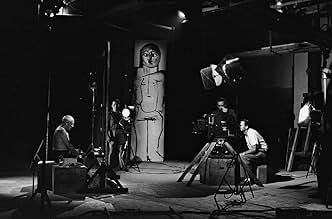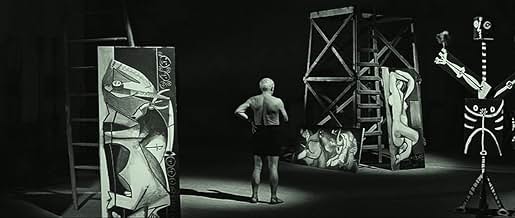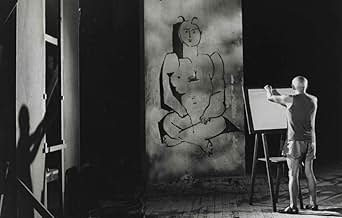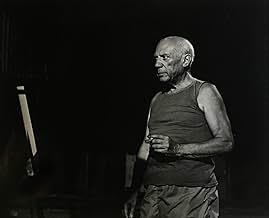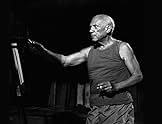IMDb-BEWERTUNG
7,6/10
2752
IHRE BEWERTUNG
Eine filmische Dokumentation über Pablo Picasso, wie er zahlreiche Leinwände für die Kamera bemalt, so dass wir an seinem kreativen Schaffensprozess teilhaben können.Eine filmische Dokumentation über Pablo Picasso, wie er zahlreiche Leinwände für die Kamera bemalt, so dass wir an seinem kreativen Schaffensprozess teilhaben können.Eine filmische Dokumentation über Pablo Picasso, wie er zahlreiche Leinwände für die Kamera bemalt, so dass wir an seinem kreativen Schaffensprozess teilhaben können.
- Regie
- Hauptbesetzung
- Auszeichnungen
- 1 Gewinn & 1 Nominierung insgesamt
Pablo Picasso
- Self
- (as Picasso)
Henri-Georges Clouzot
- Self
- (Nicht genannt)
Claude Renoir
- Self
- (Nicht genannt)
Handlung
WUSSTEST DU SCHON:
- WissenswertesSpecial transparent 'canvases' were constructed so that Pablo Picasso could paint on one side and 'Renoir, Claude' and Henri-Georges Clouzot could film the other.
- Zitate
Pablo Picasso: I do not look for, I find!
- VerbindungenFeatured in Picasso (1985)
Ausgewählte Rezension
If there was one word to describe this film for me, it would be "inspirational". And I think anyone who practices art or appreciates the process of art, can find this film enjoyable to watch. The film's title speaks for itself. We are engaged in an experimental documentary watching a prodigy at work and trying to unravel the magic of how it all happens. In the beginning there is a voice-over narrated introduction to the film, "Nobody knew what Rimbaud thought of when he wrote the poem "the drunk boat"." And then we realize that we are in for a real treat. Who would ever guess that the master of cubism would allow us to see his creative ideas at work? Most artists are very stubborn about this sort of thing, but then again most famous artists are also pretty ego-centric. The film places the camera behind a canvas that leaves the image transparent so that we can see the painting process without looking over the shoulder. There is a beautiful classical score along with this film and as the drawings progress, Picasso then takes on bigger challenges with paintings. The pacing is just right where the drawing process starts slow and then the strokes become faster with time-lapse photography. There is an amazing moment where the cameraman warns Picasso that he is about to run out of film. Picasso asks how many feet is left and calculates the timing of his painting and just at the last second, Picasso transforms the entire piece into something unexpected and radically different. We can see the spontaneity and playfulness in his work. The end is a mural shaped painting that evolves through many stages until Picasso says something like "its ruined. I have ruined the painting and yet at the same time, its improving." This is an indication of Picasso's fearless drive. When he paints, he is on fire. He works diligently for hours. Its fascinating to see little figures that he will paint over and over with more detail or more color. He wants to emphasize details that seem so ambiguous and its as if he's saying to the audience "look at this" "keep looking at this" "this is important." I first saw this film in the theater when I was about ten or twelve years old. I'm glad my family friends took me to see this. It has inspired me throughout the years. I saw the film again when I was twenty-four and it was just as I remembered it. After it was over, I did the same thing I did when I first saw the film; I pulled out a sketchbook and started drawing. This film is a real treat.
- mcshortfilm
- 3. Aug. 2005
- Permalink
Top-Auswahl
Melde dich zum Bewerten an und greife auf die Watchlist für personalisierte Empfehlungen zu.
- How long is The Mystery of Picasso?Powered by Alexa
Details
- Erscheinungsdatum
- Herkunftsland
- Sprache
- Auch bekannt als
- The Mystery of Picasso
- Produktionsfirma
- Weitere beteiligte Unternehmen bei IMDbPro anzeigen
Box Office
- Bruttoertrag in den USA und Kanada
- 267.836 $
- Eröffnungswochenende in den USA und in Kanada
- 19.143 $
- 23. Feb. 1986
- Laufzeit1 Stunde 18 Minuten
- Farbe
Zu dieser Seite beitragen
Bearbeitung vorschlagen oder fehlenden Inhalt hinzufügen

Oberste Lücke
By what name was Das Wunder Picasso (1956) officially released in India in English?
Antwort

